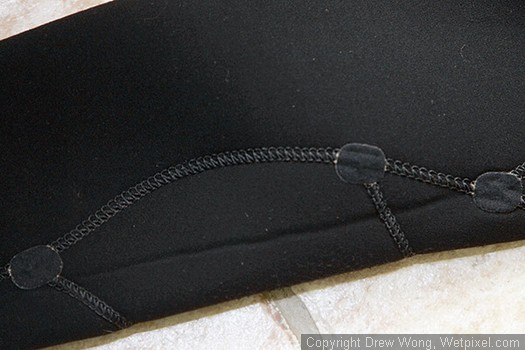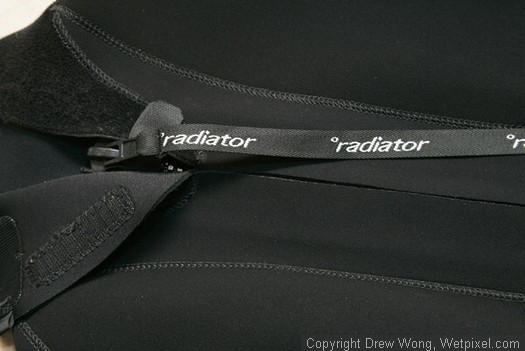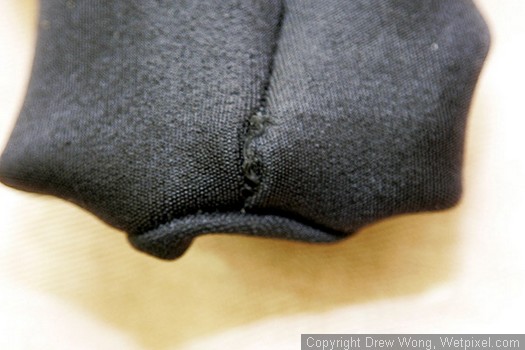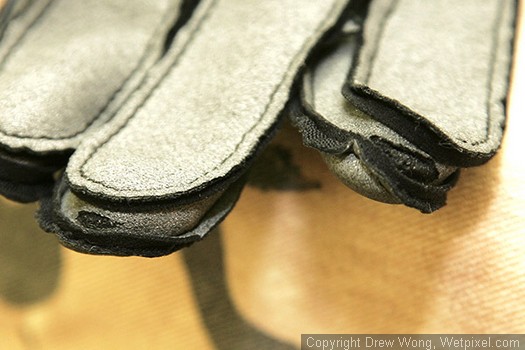Radiator 3/2 Steamer wetsuit field test and review
* This review was written and sent to Radiator’s Brand Director Bob Lushey, for comments and feedback. I thought it’d be interesting to leave some of his feedback (in italics) for readers.
First of all, let it be known, I am a Warm Water Wimp. I wear 5mm suits for water from 20-25°C. I have a 7mm semi-dry I use for water 15-19°C, under which I dive dry. I have less than 9.5% body fat and have very little “bioprene” to insulate me.
A little prologueIn 2000, I went surfing in the Gold Coast of Australia. I was getting cold after a few hours on the waves but felt a wetsuit would be too much. A gorgeous girl named Belinda who worked at a local surf store (who also happened to be their model) swore by this 0.5mm neoprene titanium lined rash guard shirt named Radiator (Our strongest sales tool has been personal recommendation. We have a number of Belindas around the place – by the sound of it maybe not all as cute though!) She even modeled it for me. I’m not sure if it was good judgement or gah gah hormones, but I bought the shirt! (you’re obviously a weak bastard like the rest of us but in this case it worked out OK).
For the next week I felt warm enough to hang on the waves for hours without getting cold, all due to this titanium lined shirt. The neoprene kept the shirt tight on my body and kept me warm. I wasn’t just blinded by beauty! (note to self: Listen to women more often… even gorgeous ones!) I started using that shirt under my scuba wetsuits after that and found I could go 1-2mm less neoprene in the torso region because of it. (I always claim about 2mms worth of warmth based on “anecdotal” evidence. We are also trying to verify this scientifically but it is very difficult to do because there are so many variables.)
The Search For Less is MoreI was looking for a wetsuit which had great flexibility in the arms and not so buoyant, as in not so thick, for shallow water diving during my South Africa dive trip. On this trip I’d be jumping in and out of a Rigid-bottom Inflatable Boat everyday looking for activity. The water temperature would range from 16-22°C (64-72°F). I also wanted something that would dry fast so it wouldn’t be so wet that I’d cry bloody murder while putting it on in the South African winter mornings.
There were of course silver, gold, merino and polartec lined wetsuits but having tried a few of those in 5mm, I found they didn’t dry as quickly and were still pretty buoyant. My Radiator shirt is still hanging tough so I decided to check out their website for kicks. Cowabunga dude! When I was first introduced to Radiator, they primarily made wetsuits for surfers, but have since delved into scuba gear. They had a 3/2mm wetsuit codenamed the Sealed Steamer which had a similar construction to the shirt I still use 7 years, and at least 600 dives. Constructed for surfers, the design allowed more mobility in the joints and the titanium lining promised to add another 1mm of neoprene warmth to the suit. Since I had a friend coming from Sydney, I decided to try the wetsuit and the other accessories like the full hood, gloves and socks, all lined with the same closed cell core titanium lining.
Just what is this titanium lining and what’s so special? Without getting into too much marketing terminology and boring stuff, the lining is basically a 4-layer laminated material consisting of:
• Nylon outer - for strength and durability
• Titanium - to keep cold out
• Closed (nitrogen) cell core –for insulation
• SCS “Slipskin” inner - for comfort and to reflect body heat.
Lots of technical marketing terms don’t impress me if it doesn’t work as promised but since the shirt (technically Radiator calls it a vest) had worked well, I decided to give them a try.
I’m 5’11 and lean, medium-large shoulder and according to their size chart on their website, I was a MT (Medium Tall). The flanged hood was Large size and the gloves I decided to try Medium for a tighter fit. The socks were also Large for my size 11 feet.
The Field TestOnce it arrived, I immediately checked it out. The stitching looked great. There were no hems on the legs or arms (this is because it actually allows the suit to fit better. It sits flatter and closer to the skin than a hem so less water entry. Most hem systems also restrict the stretch making it harder to pull the suit over your feet and hands. Classic KISS theory. By the way it does not affect durability at all.) but just cut material. Basically the suit is a back zip, 3mm in the torso, arms and the front quadriceps area. The rest is just 2mm. The zipper has 1 velcro fastener near the top of the zipper to stop it from going back down as you move your torso. There’s also a double layer of neoprene running along the zipper, acting both to protect the wearer from feeling the zipper and also as cushion against the BCD in my case, a backplate. (Correct. A lot of divers don’t realise that. It also assists the seal of the suit with the tank pushing on it. Back zip suits also enable much better fit and are far easier to get on and off - as long as you can reach the pull tie), The arms and legs are designed to allow the natural bend of the elbow and knees respectively, and there are thin knee pads as well.
I decided to wash it immediately to test one of the more important qualities I was looking for… fast drying. I also don’t like to wear anything new unwashed. So into the soft biodegradable soap and disinfectant mix in went and hung it up to dry overnight, an 8 hour drying period.
The next morning, I found the wetsuit dry. I’m sure it was partially due to the dry ‘Berg’ wind that sometimes blows, dropping humidity to 50% or less. (Also because the suit does not absorb as much water in the first place. That is because of the very high proportion of closed cells in the neoprene core. This also provides better insulation and more warmth) Still I was a happy camper. A dry wetsuit makes me a happy man. On other days I usually have about 15 hours to dry the wetsuit and it was always dry in the lining area after that time. Still putting on the suit is cold to the skin as the lining is cold until it draws heat from your body.

The stitching is reinforced with patches at the seam joints
Putting on the wetsuit wasn’t as easy as Polartec but much easier than wearing a 7mm semi dry. The difficult areas were the legs. Wearing the wetsuit for the first time, I discovered that MT wasn’t really Medium Tall. The arms and legs were 1.5-2 inches short. I’m no monkey and my legs are 32.5 inches inseam. The label said Made in China so maybe it’s Asian sizing, which is generally one size down from US/Australian SMLXL sizing (Yes. That is basically right and we are aware of and need to correct right across the range). Fortunately, the gloves and socks extended over the exposed areas so it wasn’t a big deal. The rest of the suit felt like a good snug fit except in the length of the torso where I had to pull up on the wet suit to ensure I wasn’t being forced to hunch by the wetsuit. For guys who care, the “frontage” area was comfortable. The lining really does hug to skin, which is what it’s designed to do, and I had the indentations to prove it at the end of the day. However, the seams never felt abrasive at all.
That morning, I had to dive in on some baitballs in 19°C water. I looked at the Radiator 1.5mm hood and really didn’t trust it to keep me warm so I just put on the suit and my old Polartec lined 5mm hood. I also used the gloves and socks with my 5mm booties. With just 3 kg of lead, a reg rig on a 3 liter tank and a mini-harness made for the tank, I stayed neutral at 2m(6.6ft) with no problems. The lining held snugly to my front torso and upper back area, only a small gap developed in the lower back. Better yet, I wasn’t cold immediately. I stayed for about 20mins at 2-5m and while I did feel the water was cool and I certainly wasn’t toasty, I was comfortable in the water for such short periods. I had very good mobility, especially in the shoulder areas, showing that Radiator has its roots in the surfing industry, allowing wearers to paddle freely. The thinner wetsuit worked well in allowing a shooter freedom of movement while maintaining body warmth. I could follow the action easily, moving out of the way of predators and the sardines trying to use me as cover from them! (I know this will sound strange but we have noticed that the colder the conditions the better the suits works. We understand this is something to do with retaining core body temp rather than providing warmth. So, even if you think you are on the limit, push it a bit and you may find the suit still the same in colder conditions. In the reverse, a lot of people have told us they can wear the same suit in much warmer conditions without overheating.)

The back zip with velco fastener. You can see the raised padded back on top of the zip
Coming out of the water into the South African winter was another issue. The wind blew right through the wetsuit as the air pockets developed. I felt cold for a long time until the suit absorbed some heat from the sun. But the wind chill effect was uncomfortable. (change of conditions can do that) So I decided to wear my old Radiator shirt under the wetsuit.
For the next 10 days, I used this combination constantly in water temperatures of 18-20°C for up to 30 mins in the water with no problems. I stayed comfortably cozy after the dives. I even started using the Radiator hood on the 3rd day on. I found the neck seal didn’t really go round my neck properly (16” collar) but the snugness of the lining on my upper chest prevented water from entering too far. With the hood tucked in, it stayed snug and cozy. The zip leash was easy to find and use but I do wish the zipper was a few inches longer at the bottom. It’s a little high for me so wearing the wetsuit halfway down or more (for bathroom access) was somewhat uncomfortable. I also think the zip leash needs to have a velcro fastener at the end so it doesn’t flap around (fair enough – can do). This is a pet peeve of mine! Also with all the chafing from sitting on my high chair and bouncing around for hours every day, the wear on the suit was unnoticeable. (The key to the whole thing with Radiator is the ability to layer effectively.)

You can see the hole in the seam area of the glove. This after a fews days of wear.

The fingertips wore out after only 5 days of wear.
Unfortunately the gloves were another story. After only 5 days, a hole showed up at the wrist area and after 8 days, the index and middle finger tips were almost worn through the material. I’ve since talked to the manufacturer and they’ve acknowledged the durability problems of the gloves and are reportedly fixing it in the next production run.
I was so confident with the thermal abilities of the wetsuit that I experimented with just the wetsuit and the hood, gloves and socks on a 65 min dive in Suunto marked 22°C water. Afterall, if I could handle 19°C with the shirt, 22° should be toasty. BIG MISTAKE! While the wetsuit was fine in 19°C water for 20 mins, it wasn’t fine for 60 minutes in 22°C. I felt cold after 45 minutes and was shivering a bit on the surface when the wind blew. Next dive I put the ol’ shirt back on. I was comfortable for the 55 min dive and had no problems once back on the boat either. I felt cool but not uncomfortable. It seems the extra lining on lining helps more than a single lining. I did not however do 4-5 50+ minute dives daily, so I cannot say how well it would maintain my core temperature through a dive trip on a liveaboard for example. I will update the review after my Indonesian trip with my findings. The lined socks kept my feet warm and fit like real socks. The threading does demand you put them on a certain way and I couldn’t test their durability as I didn’t walk around with them much. The hood worked well as well, the only complaint I have is that it occasionally captured air from my exhaust and needs holes to vent the bubbles. Radiator says any leather hole puncher would do the trick (easy and common fix on all dive hoods).
Overall, I have to say I’m very happy with the Radiator wetsuit and most of the accessories. The gloves were warm and thin so it was easy to work camera controls. However, they didn’t last 5 days of minimal use. I’m interested to see how Radiator fixes this problem and if its an anomaly of the product line. Otherwise, the 0.5mm hood felt like a 2mm hood, the wetsuit on its own felt like a 4mm neoprene suit with the lined areas and the 0.5mm socks were nice and kept my feet warm. My old Radiator shirt proves Radiator products do withstand wear and tear, at least the vests anyhow.
So it’s durable and does what it promises to do…perfect product, right? Well as I always say, there’s no such thing as perfection and the catches are the price, the ability to purchase it and fit.
Here is a breakdown for what I had ordered:
RUSF Sealed Steamer: AU$649.95
RMVL Long Sleeve Vest: AU$154.95
RUAD Dive Hood: AU$59.95
RUAG Gloves: AU$64.95
RUAS Hot Socks: AU$49.95
Total: AU$979.75 (Approx US$735) *
* These prices include Australian GST of 10%, which is not applicable for export orders. So take off 10% if you are ordering from anywhere else in the world.
The wetsuit’s MSRP is AU$649.95.00, as listed below. That’s US$520 for a 3/2mm suit, albeit one that acts like a 4mm. That’s a big $/mm ratio for neoprene wear. My custom made 7mm wetsuit cost $250 and is made to measure. It’s also lasted 400+ dives, including 4 sardine run campaigns. So Radiator demands a big premium. And even if you want to buy one, in many parts of the world, you’ll have to buy it from Radiator directly in Australia, since their distribution network isn’t vast. That adds mailing costs and delays to the bill and also problems with returning products for warranty repair etc.
With such a high price tag and difficulty to purchase, would I still recommend it? Yes, I would. For camera work at shallow depths and less bulk in general, the wetsuit did its job in keeping me warm so I could shoot without the bulk of thick neoprene. In cooler waters like the subtropics, I think it’s a great suit to have. You have less bulk and better movement, which may mean the difference in getting the shot or not, especially in shallow water. Besides the in-water flexibility, the thinner suit made it easier for me to get my gear on and also getting on and off the boat. I see it like a F1 race car of the wetsuit world, high tech and expensive but works really well for what it’s designed for. It’s definitely not for the recreational diver on a budget. With photo equipment costing over thousands of dollars being so common, an expensive but useful wetsuit shouldn’t be that big a deal in the long run.
If you do order, I definitely recommend you take your own measurements and send them along with your order for the best fit. I like my wetsuits to go within 1” of my wrists and ankles. The Radiator website size chart just isn’t accurate. I’ve already decided to abandon my other wetsuits (including my new custom 5mm) and use the Radiator wetsuit/shirt combination for diving from 22+°C. I can only highly recommend the rash vest. It worked very well in combination with the wetsuit and is very durable. And boy did it look good on Belinda! On that note, check out Radiator’s poster ads created by the Furnace guys. WARNING!!! there is nudity and sexual content! You can see the ads here.
(Overall a pretty fair assessment. Our suits are for top performance and the material we use is much more expensive than standard neoprene so it is going to carry a premium. We are working on our international distribution and will be well represented in Europe and US in a little while.)
The Lowdown:
Pros:
• Titanium lining works, adds equivalent of 1mm or more of warmth without the bulk.
• Very good mobility in the joints
• Low buoyancy for the thermal protection
• Good durability in my vest, so I assume the rest of the line is as good
• Padded back area for backplates/BCD
• Fast Drying
• Gloves: warm and thin so it’s easy to actuate camera controls.
Neutrals:
• Zipper leash needs velcro fastener (fair enough easy fix)
• Small international distribution (at the moment)
Cons:
• Very high price tag
• Website size chart is off, with possible length fit problems occurring with orders. (true but being fixed)
• Gloves: Bad durability gloves. Hole in seam and finger tips worn through after 8 days.(true but being fixed)
• Neck doesn’t seal properly for me, this could be due to the fit problem. (valid - we can improve it, already have some ideas)
• No hems for arms and legs, leading to possible durability problems. (Does not affect durability but enhances fit by avoiding restrictive hems)
-Drew Wong